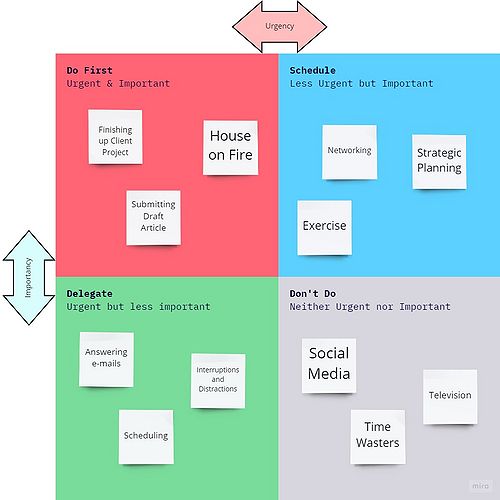Eisenhower Matrix
The Eisenhower Matrix, is a tool for organizing and prioritizing the severity of task’s Urgency and Importance. This method is named after Dwight D. Eisenhower, the 35th president of the United States, who was know for being a highly effective leader both in the military and in Government. In newer times, author of “7 habits of highly effective people”, Stephen Covey, has given his own interpretation of Eisenhower method, also known as the Time Management Matrix.
The Eisenhower Matrix is a 2-by-2 cell matrix, where the horizontal axis represents Importance and the vertical axis represents urgency. The tool is used to prioritize tasks, thus aiding the user to plan short-, mid- and long-term decision through the order of executing the tasks. One of the main aims of using the Eisenhower Matrix, is to create a higher awareness and focus on payoff rather than urgency. REF TDL
The Four Quadrants
The Eisenhower Matrix consists of four quadrants, with each of them signifying them importance of a given task.
Do First
The first quadrant, in the top left of the matrix, is called the “Do First” quadrant. The tasks assigned to this quadrant signify both their Importance and their Time-sensitivity. These tasks typically have an upcoming deadline, as well as severe consequences if postponed. However, these tasks can also be surprises from an external source, requiring a crisis-level response. Covey suggests that spending too much time in the first quadrant, due to its deadline driven nature, can cause increased stress and burn out. REF Covey
Schedule
The quadrant in the top left of the matrix is called the “Schedule” quadrant. Similarly, to the ‘Do First’ quadrant, these tasks are significant but are not time sensitive. The tasks in this quadrant are usually focused on growth and development, or ‘deep work’, as they are void of the distractions of urgency. Furthermore, by scheduling your tasks efficiently and spending more time in the second quadrant, the smaller number of foreseeable tasks end up in the first quadrant over time. This quadrant is optimal for long term-planning REF TODOIST
Delegate
The third quadrant, in the bottom left-hand side, is the ‘Delegate’ quadrant. These tasks are typically those that signify and embody the ‘Mere urgency effect’, because they seem urgent, but don’t carry any importance or significant payoff for completion. If one is to spend too much time in this quadrant, the work becomes less meaningful as the focus is not on the matters that are important to the individual. REF TODOIST By identifying the tasks that can be delegated, either to services or co-workers, allows more energy and time to be spent on important tasks. If tasks in this quadrant cannot be delegated, they should be executed after completing tasks in the first two quadrants. REF COVEY
Don't Do
Mere Urgency Effect
_____________________________________________________________________________________________________________________________________________________________________________________
- ** * * * *Bulletpoints. (Picture coming in as well, just trying to figure out ^^)
- Origins
- Structure
The Four Quadrants - Important Urgent - Important Not-Urgent - Unimportant Urgent - Unimportant Not-Urgent
Mere-Urgency Effect - Studies o Urgency as Priority o Effect of Reminder
Application - Optimal Quadrant - Planning - Delegation - Time Tracking Limitation - Individual Assessment
